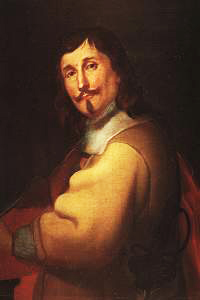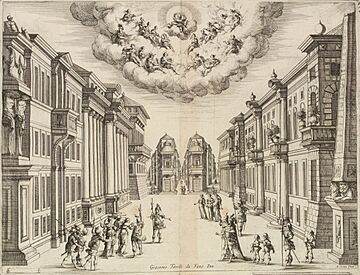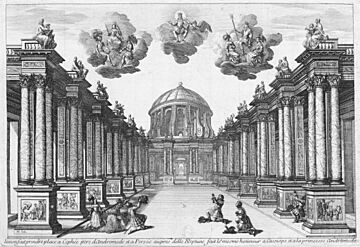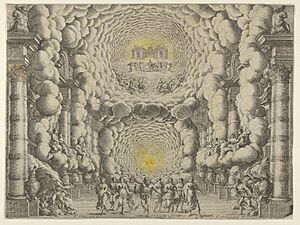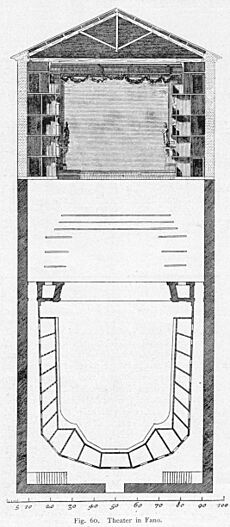Giacomo Torelli facts for kids
Giacomo Torelli (born September 1, 1608 – died June 17, 1678) was a talented Italian stage designer. He was also a painter, engineer, and architect. Torelli was famous for creating amazing stage machinery. His designs made scenery changes and special effects spectacular. Many of his designs were drawn and printed. This helps us understand 17th-century stage design today.
Contents
The Story of Giacomo Torelli
Early Life and First Stage Designs in Italy
Giacomo Torelli was born in Fano, Italy. He might have started working on plays in his hometown. He also gained experience in nearby Pesaro or Urbino.
His first known work was in January 1641. It was for the opening of the Teatro Novissimo in Venice. He helped design the scenery and stage machinery for an opera. The opera was called La finta pazza by Francesco Sacrati.
After this, he designed for two more operas by Sacrati. These were Bellerofonte in 1642 and Venere gelosa in 1643. He might have also worked on Deidamia in 1644. His last work in Venice was L'Ulisse errante in 1644.
Working in France: A New Adventure
In 1642, Cardinal Mazarin became a powerful leader in France. He was born in Italy and wanted to bring Italian opera to Paris. In 1645, Torelli was asked to come to France. He worked on a new production of La finta pazza. He used many of his designs from Venice.
Mazarin brought Italian singers to France. But to please the French audience, funny ballet dances were added. These replaced the singing parts at the end of each act. Some of the spoken parts were not sung either. The show started on December 14, 1645. It was performed in a large hall called the Petit-Bourbon. The show was a huge success! Everyone loved the amazing special effects Torelli created.
Because La finta pazza was so popular, Mazarin decided to put on another Italian opera. This one was called Egisto. It was likely by Francesco Cavalli. Torelli made changes to the Palais-Royal theatre for the stage machinery. Egisto was performed in 1646. However, it was not as successful as the first opera.
Mazarin then planned a brand new Italian opera. It was Luigi Rossi's Orfeo. Torelli worked with French designers to create the sets and effects. More big changes were made to the Palais-Royal theatre. This was to fit all the new stage machines. New Italian singers came to France. After some delays, Orfeo opened on March 2, 1647. People started to complain about Italian opera. They said it was too Italian and too expensive. But even then, Torelli's stage effects were still praised.
During a time of trouble in France (1648–1653), Torelli stayed in Paris. He designed scenery for a new French play. It was Pierre Corneille's Andromède. This play had music by Dassoucy. The usual stage for the actors was too small for Torelli's machines. So, Andromède was moved to the Petit-Bourbon. This theatre could hold more people. Many of Torelli's sets from Orfeo were used again. Andromède opened on February 1, 1650. Drawings of his sets were later published.
After King Louis XIV returned to Paris in 1653, Torelli worked more on royal ballets. The king loved dancing. Torelli is often given credit for the designs of the Ballet de la Nuit. This ballet was performed in 1653.
In 1659, another Italian stage design family arrived in Paris. They were Gaspare Vigarani and his sons. Torelli soon lost the king's favor. Torelli's time in France ended in 1661. He worked on sets for Molière's play Les fâcheux. This play was part of a big party hosted by Nicholas Fouquet. Fouquet's show was too fancy, and he ended up in prison.
Returning Home to Italy
Torelli went back to his hometown of Fano. He designed a theatre there, called the Teatro della Fortuna. His final stage design was for Il trionfo della continenza in 1677. Giacomo Torelli passed away in Fano in 1678.
Torelli's Amazing Inventions
The Pole and Chariot System
Torelli's most important invention was the Pole and Chariot system. This was a clever way to change scenery quickly. Under the stage, there were trolleys connected by ropes. These ropes led to a central spinning drum. One person under the stage could turn the drum. This would change many stage backdrops at once.
Before this, it took many stagehands to change sets slowly. Torelli's system saved a lot of work. It also created amazing scenic effects. Because of this, operas started to have many more set changes. Torelli also designed machines to make characters fly. He could also create weather effects on stage. People even called him the 'grand stregone' (great magician).
Creating Depth and Space on Stage
Torelli made the one-point-perspective set even better. His designs made the stage look like it went on forever. It seemed to stretch to the horizon and beyond. Even though he loved endless spaces, Torelli also created "closed" spaces. Indoor scenes became more common. These often looked quite shallow.
His new machines allowed not only backdrops to change, but also the "sky" borders. This meant he could switch between indoor and outdoor scenes easily. Torelli often changed between open and closed sets. This created a new rhythm in the visual part of the opera. He also experimented with different types of stage space. Sometimes, he would put a hill or fountain in the front of an outdoor set. This would let the audience only see glimpses of the background.
In 1660, the Petit-Bourbon theatre was torn down. This was to make room for the Louvre palace. Another designer, Vigarani, got Torelli's stage machines. Sadly, he destroyed them instead of using them. But Torelli's drawings survived! They were later shown in a famous book called Diderot's Encyclopédie in 1772. Torelli is also thought to have written a strong criticism of Vigarani's theatre.
Images for kids


